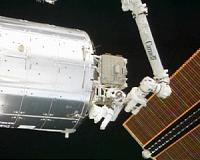 |
Washington DC (SPX) Mar 09, 2011 Like a human who just went through laser vision correction, the International Space Station (ISS) recently got a clearer view of our world. That improved view is opening up new vistas for students in American classrooms. The Window Observational Research Facility (WORF) was delivered to the ISS in April 2010 on the STS-131 mission of Space Shuttle Discovery. It was installed and prepped on the Destiny Laboratory over the past year, and includes the highest quality optics ever flown on a human-occupied spacecraft. The arrival of the WORF has allowed astronauts to permanently remove a protective, non-optical "scratch pane" on the window, which had often blurred images. The WORF also provides a highly stable mounting platform to hold cameras and sensors steady, while offering power, command, data, and cooling connections. With the WORF, the high-quality optics of the nadir viewing window-looking "straight down" towards the Earth-are now fully utilized for the first time since Destiny was launched in 2001. "Optically speaking, the scratch panes limited the resolution that could be obtained with spectral imagers or cameras," said former astronaut Mario Runco, who was part of the design and development teams for the WORF, and now serves as the lead for spacecraft window optics and window utilization at NASA's Johnson Space Center. "With the WORF finally in place, we can now make full use of the investment in an optical quality window for Earth science and observation." The subject of the first test image from the WORF was British Columbia's snow-capped mountains and coastline in western Canada. The image, captured with a 50 millimeter lens on January 17, 2011, features an area just north of Vancouver Island, centered at 51.8 degrees north latitude and 127.9 degrees west longitude, and covering an area approximately 200 kilometers (124 miles) by 134 kilometers (83 miles). Calvert Island is visible at image left, and the glaciers of the Heiltskuk Ice Field in the Coast Mountains are visible at image right. In between the two are Oweekeno Lake and inlet. While it's not a particularly unique image, it is notable for the clarity and sharpness of ground features even though it was taken with a wide-angle lens. It is a significant improvement from similar imagery acquired through the Destiny lab window when the non-optical quality pane was in place. The image was taken to test the control computer and camera associated with the EarthKAM payload, an educational outreach project that allows middle school students to remotely take pictures of their home planet from the unique perspective of the space station, 220 miles above the Earth's surface. "We are very excited to have a new camera system that appears to be functional and taking incredible images," said Karen Flammer, who manages EarthKAM operations at the University of California, San Diego.
Share This Article With Planet Earth
Related Links Earth Observatory Station at NASA Station and More at Roscosmos S.P. Korolev RSC Energia Watch NASA TV via Space.TV Space Station News at Space-Travel.Com
 Spacewalkers Continue To Complete Tasks
Spacewalkers Continue To Complete TasksHouston TX (SPX) Mar 03, 2011 Spacewalker Alvin Drew installed a light on the Crew Equipment Translation Aid cart and affixed insulation to a valve module fluid line on a left hand truss segment radiator beam. Spacewalker Steve Bowen installed a lens cover on the station robotic arm's elbow joint camera, which will protect the lens from erosion that might be caused by visiting spacecraft thrusters. During space s ... read more |
|
| The content herein, unless otherwise known to be public domain, are Copyright 1995-2010 - SpaceDaily. AFP and UPI Wire Stories are copyright Agence France-Presse and United Press International. ESA Portal Reports are copyright European Space Agency. All NASA sourced material is public domain. Additional copyrights may apply in whole or part to other bona fide parties. Advertising does not imply endorsement,agreement or approval of any opinions, statements or information provided by SpaceDaily on any Web page published or hosted by SpaceDaily. Privacy Statement |